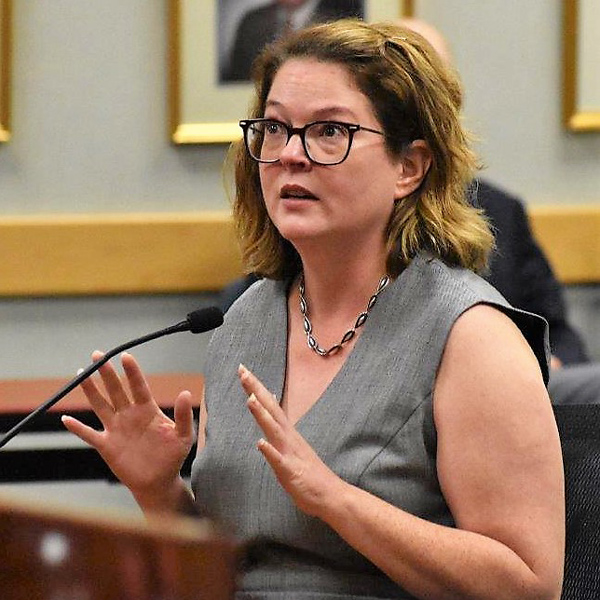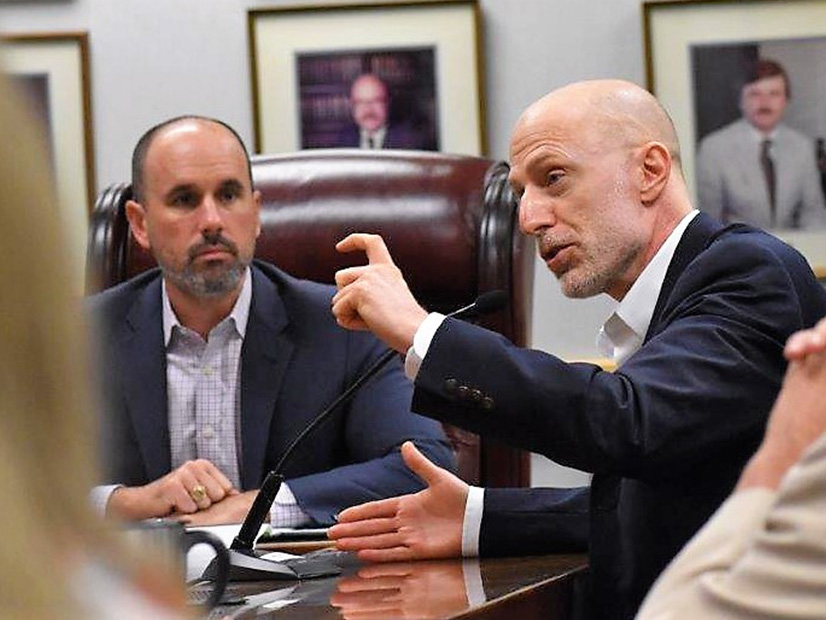The week began for ERCOT with a call for conservation on June 14 as unusually warm weather — even for Texas in June — and unexpected thermal generation outages threatened the state’s grid.
It ended quietly Friday evening when the grid operator, without fanfare, resumed normal operations.
In between, Texans spooked by ERCOT’s near collapse following the February winter storm and a Level 1 energy emergency alert in April reduced their consumption just enough to avoid further disaster.
Addressing the Public Utility Commission during an open meeting last Thursday, Woody Rickerson, ERCOT’s vice president of grid planning and operations, thanked Texans for doing their part.
“I think [conservation has] shown to be a very effective tool,” Rickerson said. “We’ve seen good response all week. Because of those actions, we’ve kept the grid in a very reliable state. Conservation gives us a tool to balance the load side of the equation.”
During the open meeting, Commissioners Peter Lake and Will McAdams repeatedly referred to a “confluence of events” that led to the conservation notice. With 9.1 GW of thermal resources offline at one point (three times above normal), wind resources coming in below forecast and above-normal temperatures driving record demand, ERCOT on June 14 was forced to ask customers to reduce their usage through Friday. (See Generation Outages Force ERCOT Conservation Alert.)
Staff were projecting a peak demand of 73 GW when ERCOT issued the conservation alert, but demand peaked at 69.9 GW on June 14 before dropping off. The grid operator still recorded 10 peaks above the previous record of 69.1 GW through Thursday.
“Yesterday is proof that simple conservation measures really do make a difference,” interim CEO Brad Jones said in a press release June 15.
The confluence of events, coming on the heels of the February disaster and another conservation call in April, again made ERCOT a subject of social media memes and the butt of national jokes. Late night comedian Stephen Colbert, emphasizing the “electric reliability” part of the ERCOT name, likened it to the fictional Sobriety Council of New Orleans.
“It’s kind of a misnomer,” Colbert said as his live audience laughed.
During the week, Amarillo and Texarkana both trumpeted the fact they are not part of the ERCOT grid. “We’re not getting our power from ERCOT,” KMXJ’s Michael Rivera wrote.
Both cities are in SPP’s Texas footprint. The 14-state RTO declared a resource alert June 14-16 because of outages, high energy use and other factors, but it did not ask for public action.
Texas Gov. Greg Abbott, who said “everything that needed to be done was done to fix the power grid in Texas” when he publicly signed legislation into law June 8, was noticeably quiet during the week. (See Abbott Signs Texas Grid Legislation into Law.)

The #AbbottFailedTexas hashtag trended on Twitter before the governor, saying the ERCOT grid “is better today than it’s ever been,” broke his silence during a June 16 event to announce the state would build a crowd-funded wall on its Mexican border.
“The governor is over-optimistic,” Texas energy consultant Alison Silverstein said in an email. “As the past week has illustrated, ERCOT’s generation fleet is not yet ready for the hot summer weather we know lies ahead, and ERCOT doesn’t yet have a solid grasp on generation outage scheduling.”
ERCOT told the PUC on Thursday that it is still investigating why so much thermal generation was out of service. About 10 GW of thermal and renewable generation was still offline Friday when the alert expired.
“That’s an unusual number of forced outages of thermal units,” Rickerson told the PUC. “People need to understand those are mechanical failures that are occurring. They’re not planned.”
The commissioners queried Carrie Bivens, ERCOT’s Independent Market Monitor, as to whether there was any evidence of market manipulation. She assured them that the IMM is studying the event, just as it would any market event.
“We have tools and we have things we look at to determine whether there’s any evidence of physical withholding,” Bivens said. Any behavior that is a violation, Bivens told RTO Insider, would be referred to the commission for “potential enforcement.”
She reminded Lake and McAdams that the incentives for market manipulation are lower than normal because ERCOT’s systemwide offer cap has been reduced by rule from $9,000/MWh to $2,000/MWh. Prices peaked at $2,045.75/MWh in the Texas Panhandle on June 14 and reached only $605.74/MWh in ERCOT’s congested West zone on June 15 before falling to their normal $25 to $30 range.
“It’s a big risk to take, to try and effectuate [market manipulation] and you’re not going to get as much profit out of your fleet than you would with a $9,000 cap,” Bivens said. “I don’t think the conditions are necessarily ripe from that perspective.”
Noting the mechanical failures have “put us in a tight spot,” the commissioners are considering waiving ERCOT’s 60-day confidentiality period for making generation outages public. Lake said he would file a memo capturing his thoughts before Thursday’s open meeting.
“I think that that needs to be looked at,” McAdams said. “I want both the public and the legislature to understand that when forced outages occur … there are financial penalties. However, peer pressure is a real deal. Public eyes on these individual events may have a benefit.”
The commissioners noted several private companies already scrape grid operators’ market data for sale to market participants. Bloomberg on Friday named the four largest plants behind the thermal outages: Luminant’s Comanche Peak nuclear plant, knocked offline by a transformer fire on June 7 by back to full power on Saturday; Talen Energy’s Barney Davis plant; and NRG Energy’s Limestone and W.A. Parish plants.

Bivens told the PUC she wouldn’t have “strong concerns with one-off exposures” but indicated a need for some period of confidentiality. Beth Garza, Bivens’ predecessor at the IMM and now a senior fellow at R Street Institute, agreed.
“Competitive markets are most effective when market participants are focused on the costs and capabilities of their own resources,” she told RTO Insider, noting the delay of unit-specific availability information was a “regulatory compromise.”
“I support it as an effective general practice,” she said. “However, I would also support the ability for ERCOT to make generator availability data public immediately in the aftermath of predefined events.”
Silverstein was less optimistic, saying she doubted generators would “want the PUC to expedite public release of generator performance data.”
“The answer isn’t to do more of what’s failed us twice this year alone, but to develop additional resource options including much-expanded energy efficiency and dispatchable demand response,” she said.
“There is a lot on the table that gives the commission a lot of different tools to address issues that come up. I’m just concerned about how those changes get implemented,” said attorney Michael Jewell, whose firm represents market participants before the state.
In the meantime, ERCOT will continue to tighten its load and weather forecasts and improve its outage-scheduling practices, not to mention continue to integrate more renewables than any other grid operator — all on top of incorporating the legislative measures passed on by lawmakers.
“As our grid changes, we need to be able to change our processes and tools and even people to meet demand on the grid,” Rickerson said. The grid “doesn’t look like it did 15 years ago. It makes sense not to operate it like we did 15 years ago.”



